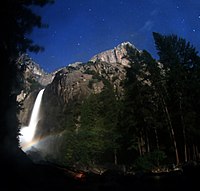Moonbow
From Wikipedia, the free encyclopedia
- For the musician, see White Rainbow.
It is difficult for the human eye to discern colors in a moonbow because the light is usually too faint to excite the cone color receptors in human eyes. As a result, they often appear to be white.[1] However, the colors in a moonbow do appear in long exposure photographs.
A true moonbow is lit from the Moon itself. A colored rainbow when the sun is setting or when it is darker out is not a moonbow because it is still produced by sunlight. Moonbows have been mentioned at least since Aristotle, in his Meteorology, circa 350 BC, and in 1847; [2], and the term moonbow was used by Nick Whelan who sighted one of the first documented moonbows in Eastern Utah.
A colored circle around the moon is not a moonbow—it is usually a 22° halo produced by refraction through hexagonal ice crystals in cirrus cloud. Colored rings close to the moon are a corona, a diffraction phenomenon produced by very small water droplets or ice crystals in clouds.
Moonbows are most easily viewed when the moon is near to full (when it is brightest). For true moonbows, other than those produced by waterfalls or sprays, the moon must be low in the sky (less than 42 degrees and preferably lower) and the sky must be dark. And of course there must be rain falling opposite the moon. This combination of requirements makes moonbows much more rare than rainbows produced by the sun.
Contents[hide] |
[edit] Notable spray moonbow locations
| | This section needs additional citations for verification. Please help improve this article by adding reliable references. Unsourced material may be challenged and removed. (November 2010) |

Spray moonbow at the Lower Yosemite Fall
[edit] See also
[edit] References
- ^ Walklet, Keith S. (2006). "Lunar Rainbows - When to View and How to Photograph a "Moonbow"". The Ansel Adams Gallery. Archived from the original on 2007-06-24. Retrieved 2007-07-09.
- ^ "The Eclectic magazine of foreign ... - Google Books". Books.google.com. Retrieved 2011-06-09.
- ^ Bailey, Bill (1995). "Cumberland Falls State Resort Park". Kentucky State Parks. Saginaw, Michigan: Glovebox Guidebooks of America. ISBN 1881139131.
[edit] External links
- "Maui's Night Sky" Time elapse photography by Wally Pacholka. Maui No Ka 'Oi Magazine Vol.14, No.3 (May 2010)
- Lunar Rainbow photos from Victoria Falls
- Moonbow picture
- Moonbow picture made with long exposure
- Moonbow in New Zealand
- Moonbow predictions - Lower Yosemite Falls - as calculated by Don Olson at Texas State
- Moving rainbow over Patagonia, all night time lapse movie
- Kentucky State Park Moonbow Dates At the bottom of the page
- Moon Light Effects: Moon Rings, Moon Dogs And Other Moon Light Phenomena...


Tidak ada komentar:
Posting Komentar